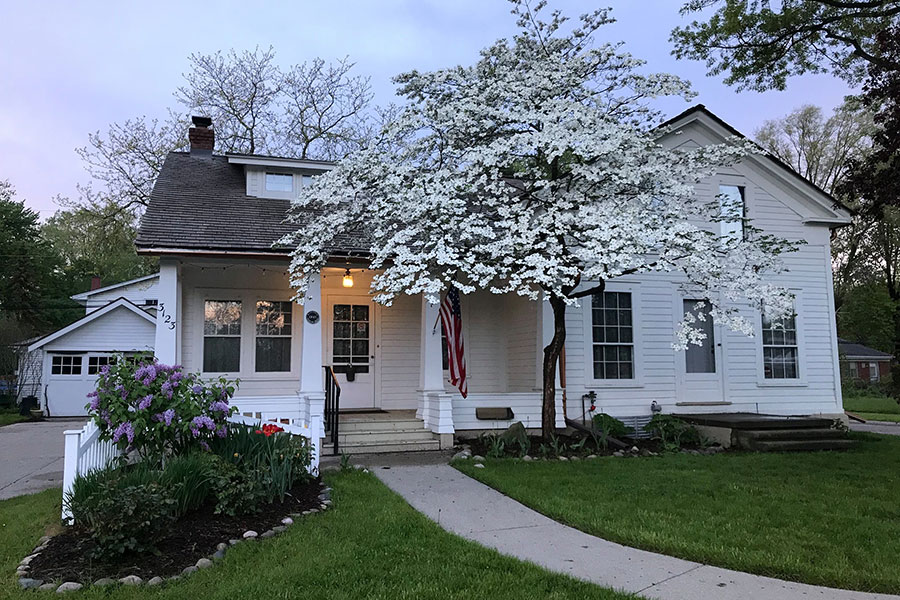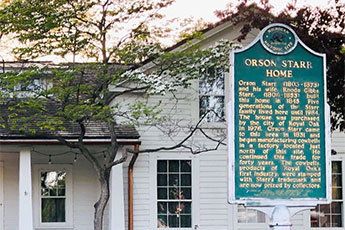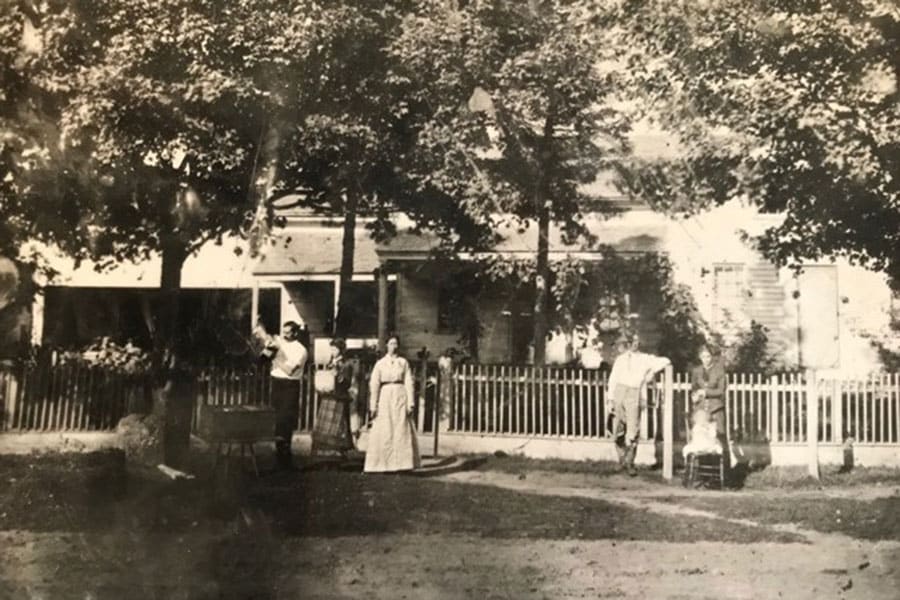
The Orson Starr House on Main Street south of 13 Mile Road, is one of Royal Oak’s hidden treasures. Foundation Trustee John Peetz paid a visit to learn about the house and the dedicated volunteers from the Historical District Commission who maintain it. They are looking for committee members! Visit the city’s website to volunteer. Here’s John’s story, along with his interview with Commission Chair Alexandra Kerrigan.
The Orson Starr House is an iconic part of Royal Oak’s history. Built in the mid-1800s, the house was originally owned by Orson Starr, a prominent businessman and early settler in the area. Starr was instrumental in the development of Royal Oak and contributed greatly to the community with his skilled crafting of cowbells which he sold all over the area. He constructed his house in 1845 and stands as a prime example of mid-19th century architecture in Michigan.
The Orson Starr House features the typical characteristics of Greek Revival farmhouse architecture style, including a low-pitched gabled roof, wide eaves with large columns, and tall, narrow windows. The house also has a large front porch, which was a common feature in Victorian-era homes, giving it a welcoming feel.
The Orson Starr households historical significance for a number of reasons. Not only does it represent Royal Oak’s first industrial product, but it also provides a glimpse into the past of one of Royal Oak’s first families. Orson Starr and his family’s impact on the town was immense — Starr Road (13 Mile Rd), Starr Market, Starr School and Starr-Jaycee Park are some examples. The house has seen many changes over the years, being lived in by five generations of the Starr family, and has been carefully preserved to maintain its historical charm.
Preserving the house has been a labor of love for the community. It was added to the National Register of Historic Places in the early 2000s, which was a crucial step in protecting it from potential development. Since then, local historical societies and preservationists have worked tirelessly to maintain its structural integrity and ensure that the house’s original features are preserved. The Royal Oak Historical Commission hopes to partner with local schools to offer educational programs for children and adults alike to learn about the importance of preservation and local history.

The house is open to the public, and there are a variety of tours throughout the year. Docents are incredibly knowledgeable about the history of the house and the surrounding area, so visitors get a well-rounded experience. There are also seasonal events such as Civil War Day, annual holiday celebration, and monthly open houses. These events are designed to bring history to life and engage the community in fun and meaningful ways.
The commission is currently working on expanding educational programs, especially for local schools. They are also in the early stages of planning a restoration project to further preserve the house’s historical features, like the original flooring, replacing side porch, roof replacement and painting. This will help ensure the house remains an important part of Royal Oak’s history for many years to come. Additionally, there are opportunities to increase community involvement through volunteering, so more people can participate in the preservation process.
I would encourage everyone to visit the Orson Starr House if they haven’t already. It’s a beautiful, historic home with so much character, and it truly reflects the story of Royal Oak. Plus, it’s a wonderful way to step back in time and appreciate the architectural and cultural heritage that shaped this community. Whether you’re a history buff, an architecture enthusiast, or just looking for a peaceful place to spend an afternoon, the Orson Starr House has something for everyone.
Interview Questions
Q: Peetz: How many volunteers are there on the Royal Oak Historical Commission?
Carrigan: We are a seven-member commission, appointed by the city. At the moment we have three empty seats. There’s myself, Alexandra Kerrigan, Kathy Putnam, Rick Karlowski and Isaac Wolf. We also have a wonderful volunteer docent who has been giving tours for many years, Donald Calder.
Q: What responsibilities/duties do the volunteers have?
We oversee the Orson Starr House, to maintain its cleanliness, structural integrity, and general upkeep. We manage restoration projects, open houses and events and curating. We also give tours and educate the visitors of the house on the history of the Starr family and Royal Oak.
Q: What is your annual budget and how are funds directed to the House for maintenance, repairs and utilities etc?
Our normal annual budget is usually $10,000 but changes with planned repairs (for example our upcoming critical roof replacement).
The commission notifies the city if maintenance or repairs are needed. Once the information has been relayed it is handled by the city’s building maintenance, and they will submit the charges to the city if they deem a private contractor is needed. However, most of the time it is done by the city maintenance.

Q: What are some things that you think the public doesn’t know about the Orson Starr House?
The house is very fascinating, and rich with history. It is Royal Oak’s oldest standing home and was originally surrounded by 80 acres purchased by Orson Starr for $160 in the 1830s. It was a working farm with hired help and many artifacts have been found in the ground around the property, including animal bones, farming equipment, broken pottery and coins. For a period of time one of the descendants of Orson Starr was married to a funeral director and the house served as a funeral parlor.
The cowbells Orson Starr manufactured on site of the house have been found all over the country, as far as California and are sought after by collectors. It is said you could hear the bells 2 miles away.
What is required to do the ghost tour?
We are partnered with a host group, Flyer Paranormal, who set up events where guests can use various equipment on three-to-four hour investigation with two different time slots. You can find scheduled paranormal events on their Facebook page and website flyerparanormal.com and purchase tickets through their site. Half of the ticket price goes back to the house as a donation. Before the event you get a historical tour of the house given by one of our commission members.
Q: How is the house received by the public/what could make it better?
Our guests that receive a tour are always impressed by the antique artifacts and preservation of the house. The reccurring statement at our open houses and events is “I’ve lived in Royal Oak my whole life and never knew this was here!” which always makes the time and energy we put into the Starr house worth it. People love that it has the feel of Greenfield Village, but they may tour the entire house, upstairs and even the basement while having any questions answered on the way. Most people stay at the house for about an hour, taking in the history of the Starr family.
We do struggle getting the public’s attention to the existence of the house. The signage isn’t eye-catching and needs to be updated. Getting our events advertised/publicized by the city would help with visitor numbers. We also lack public interest in volunteering and we’d like the public to know there is ample opportunity for volunteering if they’re interested, they don’t have to commit to being on the commission to be a part of the Starr house.










